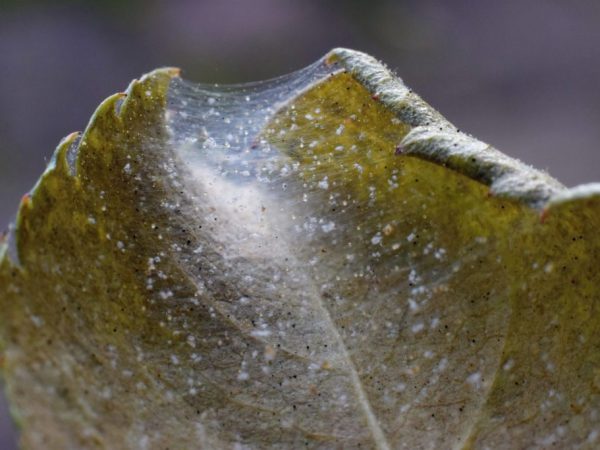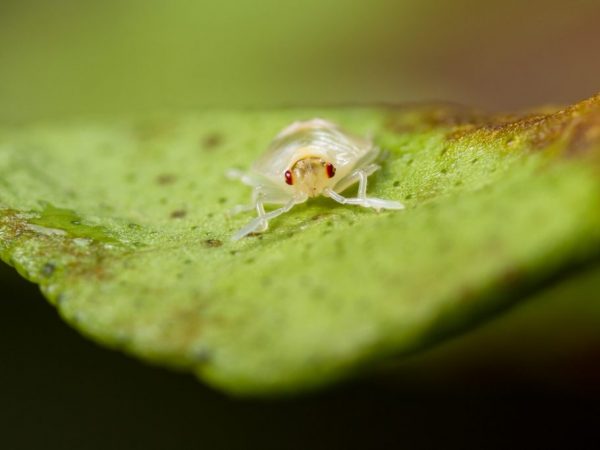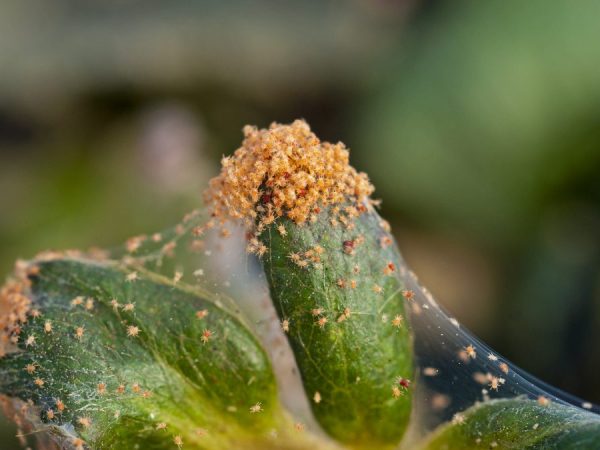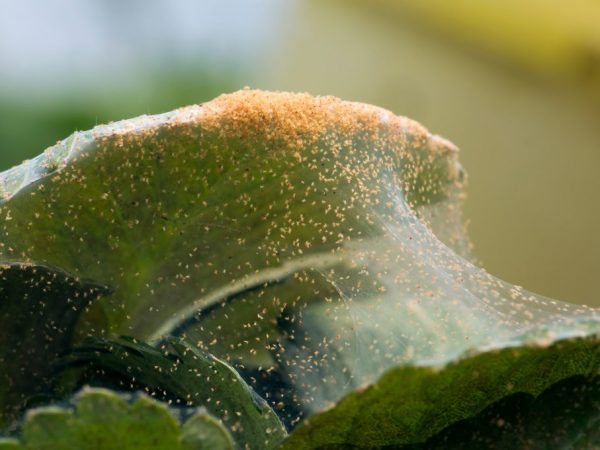Fighting spider mites on an apple tree
A spider mite appears on an apple tree under warm weather conditions. It feeds on plant juices, thereby weakening the trees. As a result, they lose some of their foliage, disrupting the process of photosynthesis. Young apple trees begin to lag behind in development, and fruiting ones reduce crop productivity.
- Signs of appearance
- Description of varieties
- Fruit red
- Fruit brown
- Gallic
- Kidney
- Schlechtendahl's tick
- What harm does
- Effective ways to fight
- Chemicals
- Biological methods
- Traditional methods
- When to process
- Until the buds open
- Before inflorescences appear
- At the flowering stage
- At the fruiting stage
- After harvest
- Prophylaxis

Fighting spider mites on an apple tree
Signs of appearance
The spider mite is a member of the arachnid family.
It is small in size, growing no more than 1 mm in length. It is possible to see it from the underside of the foliage, where it is attached by punctures in the leaf tissue, sucking the plant sap out of them.
In places of punctures on the upper side of the leaves, necrosis is formed - a white, yellow or brown spot formed from dead tissue cells.
With a massive attack of a tick on an apple tree, capable of producing up to 5 generations per year, gardeners often face the complete death of a garden culture.
A large colony of a pest that has settled on apple leaves looks like a bloom outwardly. When a large tick-borne population is reached, a cobweb becomes clearly visible on the foliage.
Description of varieties
There are many species in the family of arachnid mites. Most of them are too small, so they can only be recognized with a magnifying glass.
Fruit red
The fruiting red appearance is up to 0.4 mm in size, It has an oval-shaped red body.
A large population looks like a single spot with a yellowish tinge, located along the leaf vein.
Fruit brown
The fruiting brown variety has a flat body up to 0.6 mm long, painted in a brown shade. Prefers to settle on the kidneys.
Its presence is recognized by the remains of silvery larval skins after molting, which accumulate on the bark of trees.
Gallic
The Gaulish species prefers a secretive lifestyle, hiding inside twisted foliage and buds. Its size is up to 0.25 mm, the shape is elongated, oval, tapering to the posterior base, the color is white.
On foliage, the population forms galls - yellow or brown bulges of a spherical shape, from which it takes its name.
Kidney

Pests can kill all kidneys
The kidney species is considered the most dangerous, because he prefers to settle inside the buds on young shoots, taking away their chance to develop further.
Its length is no more than 0.2 mm. The shape of the body is round, elongated, worm-like. The color is white or with a yellowish tinge.
As a result of its presence on the apple tree, deformed, diseased kidneys of large sizes appear.
Schlechtendahl's tick
The tick-borne Schlechtendahl is less common. The pest is up to 0.2 mm long, the color of the body is yellowish with brown.
Differs in increased fertility: females are able to lay up to 2 million eggs during their life cycle.
Due to the active nutrition of these pests, the processes of photosynthesis are disrupted in the foliage, and it falls off.
What harm does
The main harm from a spider mite is the disruption of photosynthesis in foliage due to tissue damage, as well as a weakening of the resistance of trees to viral, bacterial and fungal infections due to a lack of plant juices for good nutrition.
As a result of the active development of tick-borne colonies:
- young apple trees are suspended in development;
- weakened mature trees become objects of infection;
- gardeners lose their crops and face the complete loss of horticultural crops.
Effective ways to fight
The fight against spider mites on apple trees should be carried out in a comprehensive manner, using completely different means at the same time.
Chemicals
With a massive appearance of a pest, the pest can be destroyed by using special preparations:
- Fufanon;
- Karbofos;
- Zeon;
- Bi58 and similar.
They contain malathion, which has a quick destructive effect on the pest, and has a complex effect, while simultaneously destroying other pests - scale insects, leaf rollers, moths and others.
Apply by spraying or dusting in dry weather without wind. Used 30 days before the planned harvest.
The destructive effect occurs on the second or third day after treatment. The permissible number of treatments per season is no more than 2.

It is recommended to alternate preparations for treatment
Targeted chemicals:
- Sunmight;
- Maurice;
- Demitan and the like.
They have an increased, up to 20 days, period of protection against the tick-borne parasite. Many of them include Propargite as an active ingredient. The advantage of using them is the fact that they only act on the pest, without rendering toxic effects on other insects.
It is recommended to alternate preparations so that resistance does not arise.
Biological methods
Biological methods of control allow you to destroy the tick without causing toxic harm to the apple tree and its fruits.
However, they are less effective and are unable to fight at low ambient temperatures, starting to work when the air warms up to 18 ° C and above.
These drugs include Fitoverm and Apollo, they contain waste products of fungal microorganisms that are toxic to the tick.
The advantage is the possibility of using them before harvesting (in 2 days) and an increase in the frequency of treatments per season. They are also capable of destructively affecting only adults, without destroying tick-borne larvae.
Traditional methods
Folk remedies help to get rid of the attack of ticks without causing toxic damage to apple trees:
- garlic - 50 g pour 10 liters of water, add up to 40 grams of laundry soap and spray the trees from top to bottom;
- tar soap - 100 g per 10 liters of water, sprayed weekly;
- onions - an infusion of 200 g of onion husks and 10 liters of water, aged for 1 hour, spray the garden culture in the affected areas;
- horseradish - chopped vegetable (400 g) is infused in 10 liters of water for 2-3 hours and sprayed with apple trees;
- black henbane - a poisonous berry (2 kg) is boiled in 10 liters of water, the volume of liquid is increased to 10 liters and the plantings are sprayed;
- Apple cider vinegar (1 tablespoon in 1 liter of water) also helps to resist aphids and fungus.
Folk remedies do not show the proper effectiveness in a mass attack and are used more often for prevention purposes, they can also be used in parallel with other methods of struggle.
When to process
Protect apple trees from spider mites throughout the growing season.
Until the buds open
The initial anti-mite treatment in the spring falls on the time before the blooming of apple buds, i.e.until about March. It destroys overwintered individuals.
Treatment begins at an ambient temperature of 5 ° C and above, using drugs of acaricidal action or copper and iron vitriol. Trees and soil around the trunks are cultivated.
Before inflorescences appear
Secondary anti-mite treatment falls on the time after the blossoming buds until the inflorescences appear. This is usually May.

Insecticides will help get rid of the pest
To protect apple trees from pests at this stage, insecticidal or acaricidal preparations are used.
At the flowering stage
During the flowering period of apple trees, treatment is not applied, because the active components included in them adversely affect the fruits and lead to the death of bees and other beneficial insects necessary for pollination.
Spraying is carried out in exceptional cases when there is a threat of death of the garden culture.
At the fruiting stage
The third anti-mite treatment begins at the stage of formation and growth of apples and occurs more often in June, it is stopped 30 days before the planned harvest.
For her, it is recommended to choose a different insecticidal complex than the one that was used during the initial spraying.
After harvest
Final pest control is carried out after the apples are harvested before the foliage falls. It allows you to destroy individuals remaining for the winter. At this stage, copper sulfate, urea, or insecticides are used.
Prophylaxis
The appearance of a spider mite often ends in loss of yield, reduced immunity of trees before the winter season, damage to the garden culture by bacterial, viral and fungal infections, and sometimes leads to the death of the plant.
Preventive measures to combat spider mites on an apple tree are agricultural techniques. Helps:
- autumn plowing of the soil;
- destruction of weeds, in which tick-borne eggs often remain;
- cutting off damaged branches;
- cleansing skeletal branches from backward bark, under which the pest hibernates;
- increasing the resistance of trees by applying top dressing by foliar method.
In case of a massive pest attack, the damaged shoots are cut off and burned.

